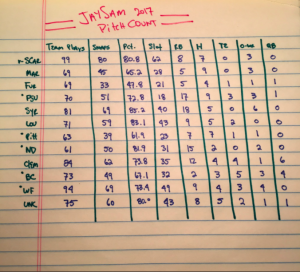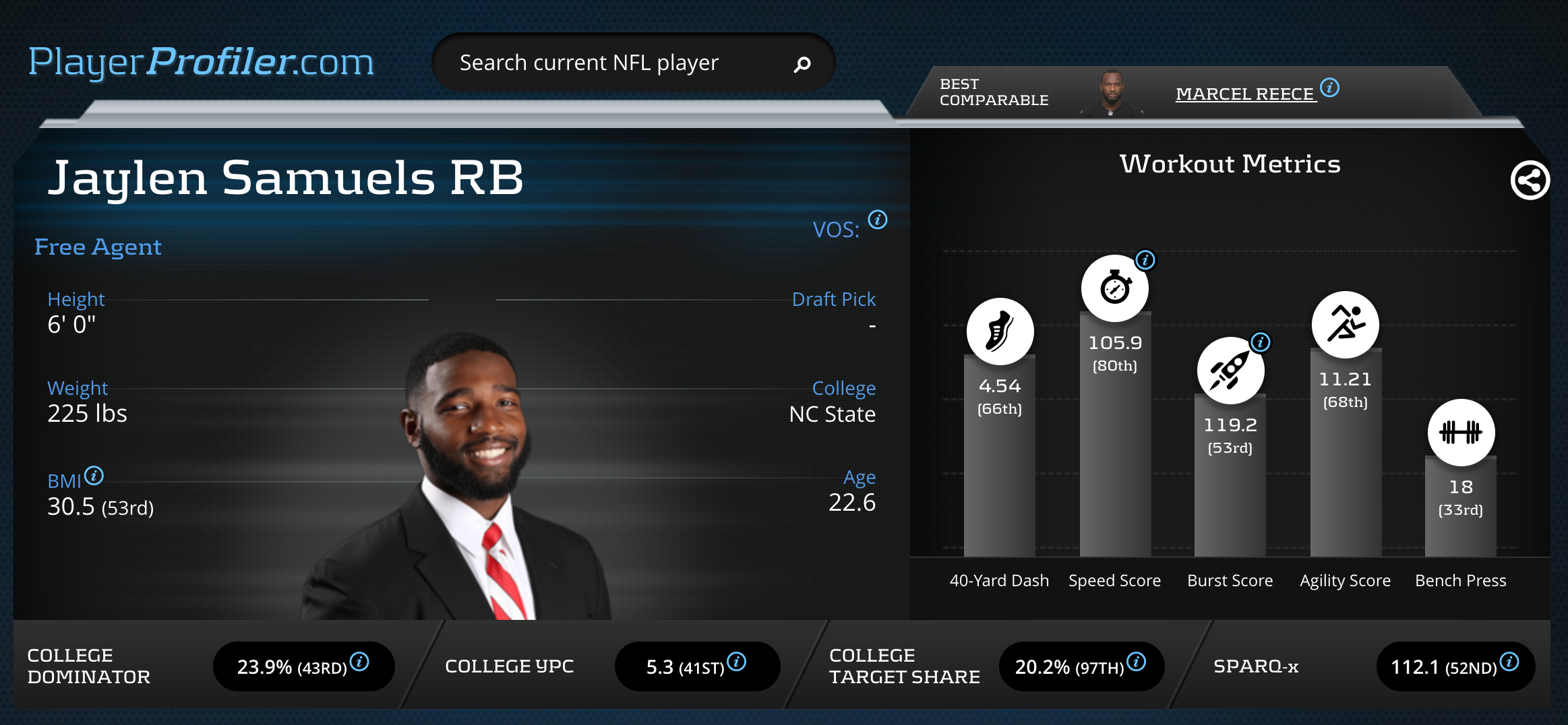At the NFL Scouting Combine, there stood a big burley man with a trimmed beard, wearing a charcoal gray hoodie with the the large letters “TE” inscribed. He humbly told the press: “I’m down to play for anybody you know, whoever is willing to give me the opportunity.” He summed up his game in one sentence, uttering the words “versatility,” “catching,” and “running” together. This young man is North Carolina State’s Jaylen Samuels, a multi-faceted offensive weapon who played football for the Wolfpack. N.C. State recruited JaySam as a tight end, however, he was mostly a slot receiver. At the Senior Bowl in January, he was listed as a running back. Two months later, he found himself thrown in with the tight ends at the 2018 NFL Combine which surprised many. It was at the Combine where Samuels proved one thing for sure, that he is an NFL-caliber athlete based on advanced stats, metrics, and analytics player profiles.
As the NFL Draft approaches, the questions looms… Who is Jaylen Samuels? And is he a tight end, a slot receiver, or running back?
College Career
Freshman Year
In his freshman year, Jaylen Samuels was 6-feet tall and 240 pounds and had Jacoby Brissett as his quarterback. He was a tight end, though he spent more time in the backfield. Samuels only touched the ball twenty-one times in total that year, but when he did, he made the most of his opportunity. He carried the ball fifteen times, averaging 9.5 yards per rushing attempt and had six receptions, averaging 16 yards a catch. It is a very small sample size but it was a sign that Samuels could do a lot when he got the ball.
Sophomore Year
As a sophomore, Jaylen Samuels saw a significant increase in usage. He was again that Swiss Army knife, playing various roles. He rushed for 368 yards on 56 attempts, averaging a solid 6.6 yards per attempt. Still weighing in at 240, he was the “big back”, scoring nine touchdowns. To put it into perspective, that is a touchdown per 6.2 carries, which is totally insane. What is even more insane is he still averaged 6.6 yards despite getting many goal line carries. As a pass catcher, however, Samuels was busier. He had an impressive 65 catches for 597 yards, for another seven touchdowns. He was Brissett’s favorite target, and was head and shoulders above the rest of the team in targets. The second most targeted receiver caught only 34 balls. What was most impressive that year was Samuels scored sixteen touchdowns, the most on the team.
https://www.youtube.com/watch?v=XxHuNgSMwUc
Samuels was emerging as a receiver and as the bruising goal line back who could find the end zone. NC State lost to Dak Prescott‘s Mississippi State in the Belk Bowl, but Samuels scored twice in his final game of the season, both as a running back. One was his typical goal line TD score, but the other one was a 48-yard scamper on 4th and 1 that clearly exhibited his speed and elusiveness.
Junior Year
Something happened in Jaylen Samuels‘ junior year. Despite playing every game, his usage went down. However, his production was generally still the same. Samuels still averaged 5.7 yards per carry; he still got the most receptions (55); he still scored 13 times. However, this was supposed to be his breakout year and it never happened. This was partially due to the fact that he was dealing with several different nagging injuries – nothing that kept him off the field but it did affect his overall usage and his ability to get open as a receiver. As for running the ball, coach Dave Doeren preferred to use senior Matthew Dayes, who out-touched Samuels 249 to 33.
Senior Year
Despite having a disappointing junior year, Jaylen Samuels was voted by his teammates to wear number-1 jersey, which is a big deal at NC State. It means many considered him the team’s leader. Coach Doeren was happy to make Samuels the leader because “JaySam shows up every day with the same work ethic, the same attitude and the same effort and he is an excellent leader for our team.” And it was just the thing Samuels needed. Wearing number-1 did make a difference because it was Samuel’s best year in many ways because he was more involved. His offensive snap share increased from 55-percent in 2016 to 73-percent in 2017. In the offseason, Samuels dropped fifteen pounds and came back to school more svelte. At six-feet tall, and weighing in at 225, he definitely looks more like a running back. Despite his new frame, he was primarily a slot receiver. He played this position 64-percent of the time, whereas he lined up as a running back/half back about 27-percent of the time. What is interesting to note is his little usage as a tight end, only lining up as one twenty-one times all season (3-percent) as Joe Giglio, from North Carolina’s the News & Observer points out above. And this is not an anomaly – in 2016 he played tight end even less at 1.5-percent.

Samuel’s 2017 Pitch Count courtesy of Joe Giglio, writer for News & Observer
Although Jaylen Samuels‘ volume increased in his senior year, it was not his best season statistically. He caught more passes (76 receptions), which placed him as N.C. State’s all-time receptions leader. But he only averaged 7.9 yards per reception. He carried the ball 77 times and averaged 5.2 yards per carry, which was his lowest average at college. However, Samuels continued to dominate where it mattered most – touchdowns. He scored the most touchdowns on his team for the third consecutive season, finding the end zone sixteen times, twelve as a runner and four as a receiver. What continued to be the impressive stat about Samuels was his touchdown to carry rate. He scored a touchdown for every 6.4 carries. All in all, Samuels has been a better, more efficient running back than a receiver but being able to both run and catch can only work to his advantage as a prospect.
Although he played mostly as a slot receiver, he simply isn’t built like one. He is too big and slow to create the necessary separation in the NFL. And there is no chance he will make it as a tight end either. Compared to the towering tight ends like Rob Gronkowski, Travis Kelce and Zach Ertz, Samuels is just too short and slight. Therefore, Samuels should enter the draft as a running back. His size points in that direction and despite never being a feature back, his efficient college stats do too.
Workout Metrics & Player Comparisons
Jaylen Samuels had a decent 2018 NFL Combine, but is by no means an elite athlete. He ran a 4.54 40-yard dash, which equates to a 105.9 Speed Score (80th-percentile among NFL running backs). He added an 11.21 Agility Score (68th-percentile), demonstrating excellent size-adjusted lateral quickness. Even his 119.2 Burst Score was above the NFL RB average.

Jaylen Samuels Advanced Stats & Metrics Profile
Although Player Profiler has current NFL free agent Marcel Reece as his best comparable player, Reece went undrafted, is a currently a free agent, and has not really done anything significant in the NFL. A more relevant player who draws parallels to Jaylen Samuels is Jordan Howard. Both are the same height with Howard slightly heavier at 230-pounds. Samuels edges Howard slightly in three categories – Speed Score, Burst Score and Bench Press. The metric that Samuels easily prevails over Howard is his Agility Score. This means he is more likely to evade tackles as well as get more yards before contact. Despite lacking agility, Howard has been quite successful in the NFL at evading tackles. He has ranked as the 14th-best running back at evading tackles for two years in a row, which is optimistic news for potential Samuels suitors.
Check out Jaylen Samuels on the PlayerProfiler’s Rookie Rankings:
Howard may only be an average athlete but has been successful at what he does – a solid and consistent between the tackles grinder for the Chicago Bears. Jaylen Samuels can be Jordan Howard but with catching ability. Howard’s college target share reached an abysmal 4.2-percent (15th-percentile) whereas Samuels was a prolific receiver, evidenced by a 20.2-percent college target share (97th-percentile). NFL teams as well as dynasty owners need to be cautious however. Unlike Howard, who has a respectable 62nd-percentile College Dominator Rating, Samuels was usurped on NC State’s running depth chart by Nyheim Hines, who currently ranks in the top-10 on PlayerProfiler’s Rookie Rankings. Howard has always been a feature back, whereas Samuels is never been one. Some will be skeptical of Samuels, believing he won’t make an impact in the NFL since he was never a true primary back in college. Then again, neither was Alvin Kamara, and he has been O-K the NFL thus far.
Best Potential Landing Spot
Jaylen Samuels has the potential to be a three-down workhorse due to his size and versatility, or a goal line back at a minimum. He could also concentrate on what he has done the most in college and be a larger pass catching threat who can line up anywhere in the field. This lack of identity might not be seen as a problem at all but could work to Samuels’ advantage. Therefore, he isn’t as dependent on a landing spot as one might think. As a utility player he will find somewhere where he can find his niche and he may never have to leave North Carolina to do just that. The Panthers, who already have a great pass-catching satellite back like Christian McCaffrey could replace J Stew (Jonathan Stewart) with JaySam. Samuels could be the complimentary bigger bruising back who can get goal line carries and catch a few passes from time to time.
Regardless, whoever ends up taking Jaylen Samuels in one of the later rounds of the rookie draft could stumble upon a bargain. Because of his size and adaptability, Samuels might be that hidden gem of 2018 that could be a difference maker on an NFL team as well as someone’s dynasty roster. Samuels is a running back who is indeed the jack of all trades but could be the master of all.



